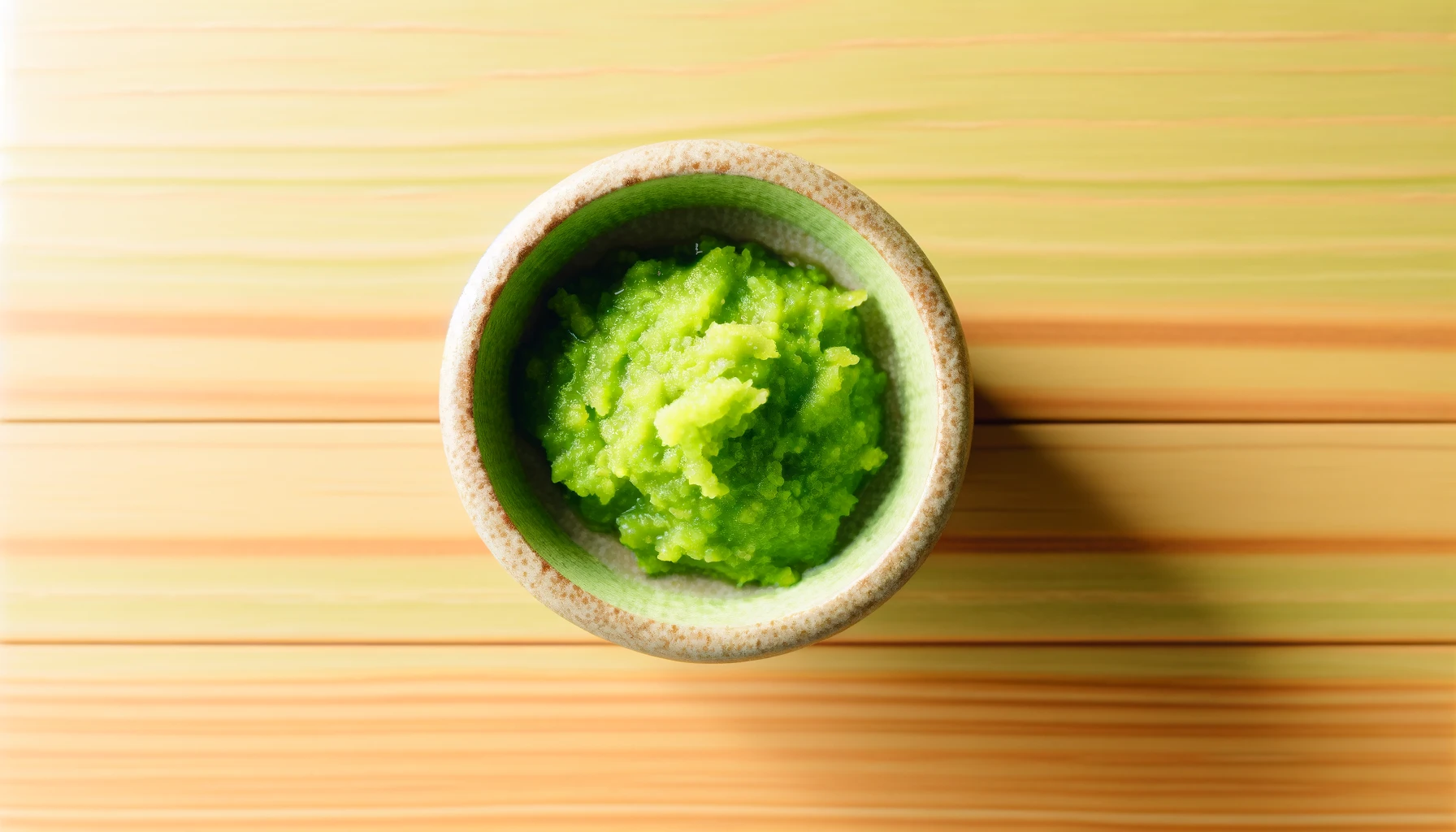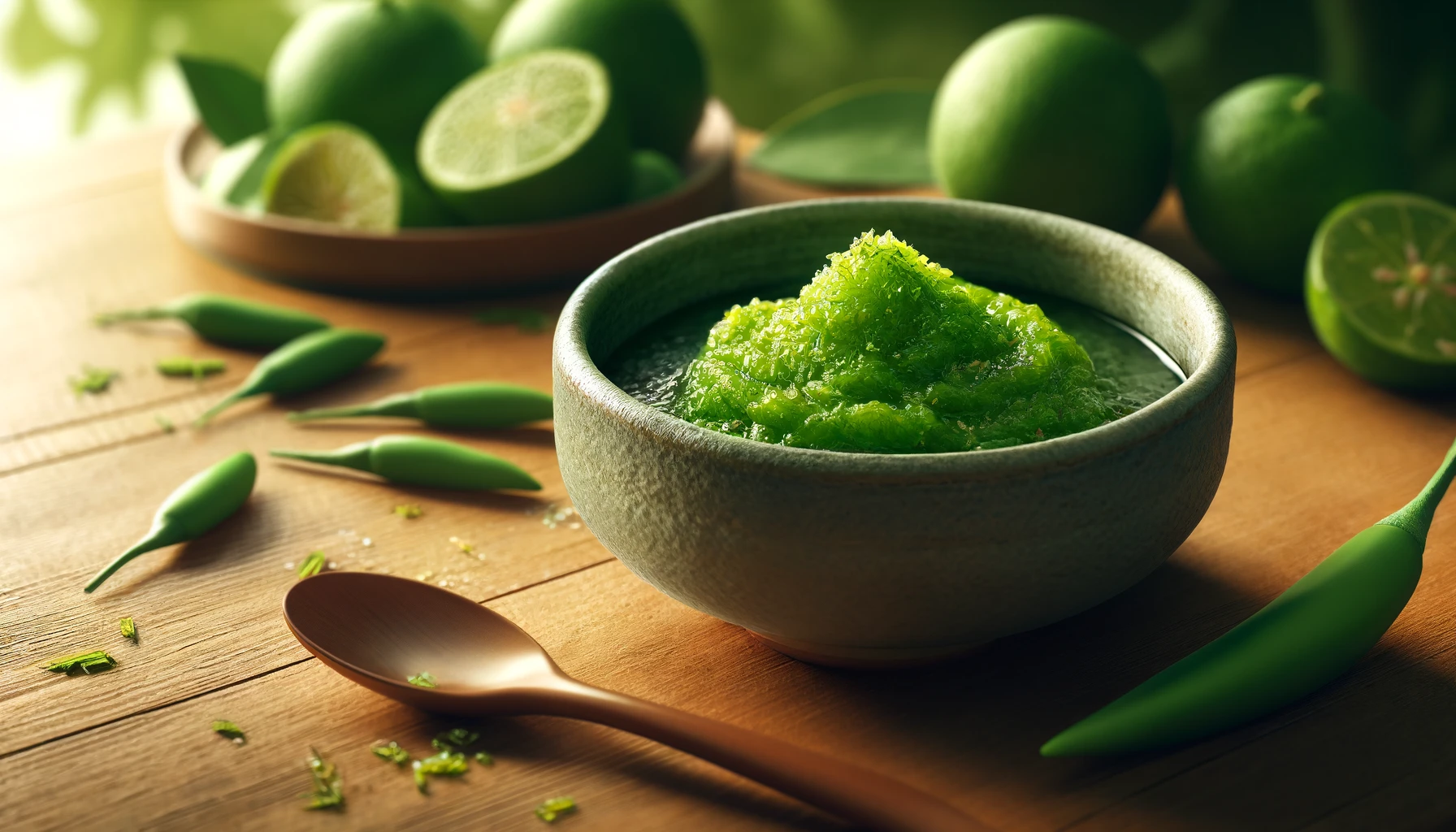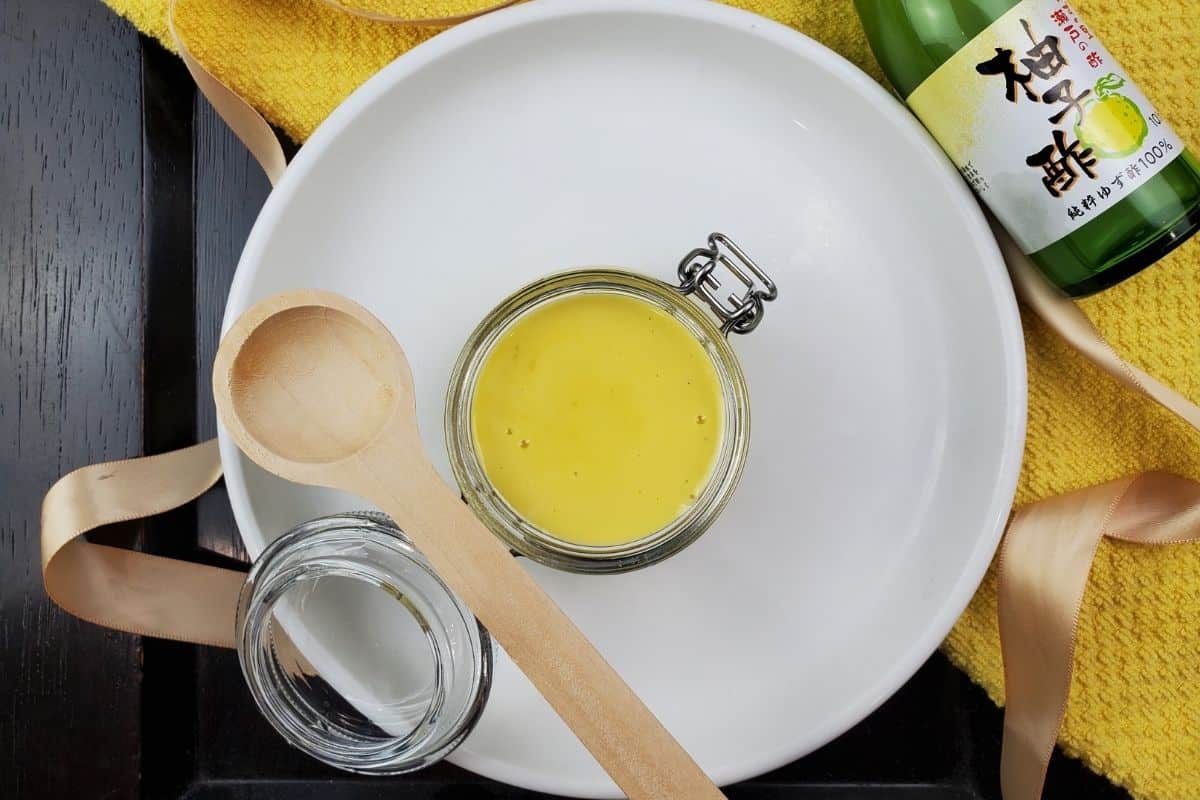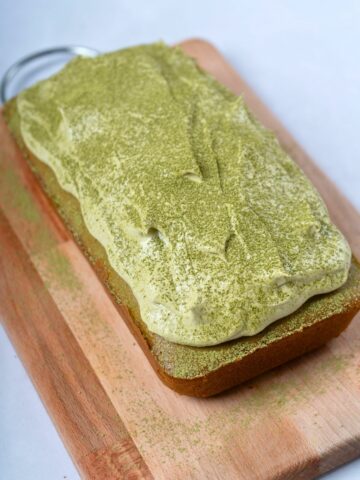Yuzu kosho is a vibrant Japanese condiment that commands attention with its bold flavor profile. It's a spicy paste that combines the aromatic zest of yuzu, a tart and fragrant citrus fruit, with the heat of green or red chili peppers and the depth of fermented salt.
This trio of ingredients is meticulously fermented, resulting in a versatile seasoning that adds a unique punch to a wide array of dishes. The distinct taste of yuzu kosho is often described as bright, with a balance of salty, spicy, and tart elements.

Jump to:
🧂 Origins and Cultural Significance
Yuzu kosho is a traditional Japanese condiment with deep roots in East Asian cuisine. Its vibrant flavor is essential in various regional dishes, reflecting Japan's culinary heritage and local produce.
Across Japan, yuzu kosho is lauded for its ability to elevate the flavors of traditional foods, such as sashimi and miso soup. The versatility of yuzu kosho sees it used as a secret ingredient by chefs worldwide to enhance sauces, marinades, and yuzu dressings with its zesty heat.
History of Yuzu Kosho
Yuzu kosho originated in Kyushu, the southernmost of Japan's 4 main islands. People believe that this zesty paste was first made in the regions of Hita in Ōita Prefecture and Soeda in Fukuoka Prefecture.
Families in these areas have a long history of crafting yuzu kosho by hand, embracing the natural bounty of yuzu citrus and fresh hot peppers both widely cultivated there. Originating from the Kyushu region, it continues to slowly gain popularity globally, enchanting the palates of culinary enthusiasts.
Yuzu Kosho in Japanese Cuisine
In Japanese cuisine, yuzu kosho is more than just a condiment; it's a flavor enhancer that's integral to many dishes. Chefs across Japan value it for its ability to add complexity to even the simplest of recipes.
It pairs exceptionally well with grilled meats and fish, and is also a favorite addition to hot pots and noodle dishes for an aromatic kick. Recognized for its simplicity and potency, yuzu kosho is actually relatively simple to make at home, offering a taste of Japanese cuisine from the comfort of your own kitchen.
Whether incorporated into restaurant-level recipes or home-cooked meals, its deep, tangy flavor is sure to add an exciting twist to any dish it accompanies.
Regional Varieties
While yuzu kosho is everywhere in Japan, distinctive regional variations are still produced in Japan. The primary differences arise from the type of chilis used and the ratio of ingredients.
In northern Kyushu, for example, they prefer the green yuzu zest and green chilis, resulting in a fresher, sharper taste. In contrast, the southern part of the island might opt for red chilis, offering a deeper, slightly sweeter flavor profile.

🌶️ Ingredients and Preparation
Yuzu kosho is a distinctive Japanese condiment that boasts of a powerful combination of spicy, tart, and salty flavors. It’s crafted from a simple mix of yuzu, a distinctively aromatic citrus fruit, and pungent green chili peppers, all bound together by salt.
Key Ingredients
- Yuzu: This citrus fruit, central to the flavor of yuzu kosho, imparts a tart, fragrant note.
- Green Chili Peppers: They add the characteristic heat to the condiment.
- Salt: Used to both season and preserve the ingredients through fermentation.
The Fermentation Process
The fermentation process intensifies the flavors and melds them together. This process can vary in duration but typically lasts for several weeks to develop a deep, complex taste.
Homemade vs. Store-Bought
- Homemade: One can make yuzu kosho using a food processor, blender, or a mortar and pestle for grinding the ingredients into a paste. The advantage of homemade Yuzu Kosho lies in the ability to adjust the flavors to personal preference, as well as the length of fermentation.
- Store-Bought: It's commonly available in supermarkets and online platforms like Amazon, often found in a tube form for convenience.

🍋 Characteristics and Varieties
Yuzu kosho is well-known for its vibrant flavor and versatility in culinary applications and it comes in two main varieties: green and red, each bringing its own unique heat and zest to dishes.
Yuzu Kosho Flavor Profile
Yuzu Kosho has a bold flavor characterized by its combination of yuzu's unique citrusy notes and the spiciness of chili peppers. The result is a tart, spicy, and somewhat umami-filled condiment that can transform and elevate a multitude of dishes, both savory and occasionally sweet.
However choosing whether to use red or green yuzu kosho is a matter of personal preference and depends on the dish it's being used in.
Green Yuzu Kosho
Green yuzu kosho is crafted from green yuzu zest and green chili peppers, creating a tart and citrusy burst with a spicy edge. It’s particularly popular for enhancing savory dishes with its fresh and vibrant flavor, balancing out the spiciness with a distinct umami quality.
Red Yuzu Kosho
Red yuzu kosho, on the other hand, is made using the zest of ripe yuzu and red chili peppers. This gives it a slightly sweeter, yet robust flavor profile compared to its green counterpart. It's highly regarded for adding a layer of complex, spicy warmth to a variety of recipes.
🍴 Culinary Uses
Yuzu kosho is a versatile Japanese condiment, adding zest, heat, and depth to various dishes. This spicy paste combines yuzu citrus zest and juice with chili peppers and salt, creating a balance of citrusy, spicy, and salty flavors.
As a Condiment
Yuzu kosho is often enjoyed as a condiment, bringing a vibrant kick to everyday meals. It can be simply dolloped onto grilled meats, such as chicken or steak, to enhance their flavor, or used as part of a kabob marinade.
It's also a great companion to sushi and sashimi, adding a spicy twist to these delicacies. In Western cuisine, yuzu kosho can substitute for mustard or horseradish, giving sandwiches and salads a unique edge.
Cooking with Yuzu Kosho
When cooking with yuzu kosho, it serves both as a seasoning and a marinade. I like mixing a small quantity into dressing, for example, imparting a zesty note to green salads with slightly sweeter ingredients.
It’s also excellent when stirred into noodles or used to season udon and ramen broths, providing an aromatic complexity. While cooking, it’s important to add yuzu kosho sparingly due to its robust flavor.
Recipes Featuring Yuzu Kosho
Kosho is an integral part of Yakitori glazes, imparts a refreshing heat to fish dishes, and can be swirled into dipping sauces for a tangy, spicy lift.
Home chefs often use it in creative ways, such as in compound butters for seafood or blended into a marinade for various meats, proving its adaptability in a myriad of culinary contexts.

👌 Pairings and Combinations
Yuzu kosho's distinctive flavor enhances a variety of dishes with its balance of citrusy heat. Understanding which ingredients it complements and the substitutes available can open up tons of new culinary possibilities.
Complementary Flavors
-
Citrus: The unique tartness of yuzu pairs excellently with other citrus fruits. Lemon and lime can bring out the bright notes in yuzu kosho, while grapefruit and orange offer a sweeter counterpart.
-
Seafood: This condiment elevates seafood dishes; a dab on grilled fish or sushi adds a burst of flavor.
Sauces and Condiments: Incorporating yuzu kosho into mayonnaise creates a dynamic spread, while blending with miso or soy sauce can result in a more complex, layered sauce like a yuzu-flavored ponzu.
-
Proteins: It's equally delectable with chicken, pork, or beef, providing a zesty contrast to the savory richness of the meats.
Substitutes for Yuzu Kosho
Homemade Yuzu Kosho: if you need to substitute for yuzu kosho, you can mix lime zest, a hint of mandarin juice, chili, and salt to mimic the flavor profile.
Prepared Condiments: while not identical, a mixture of ginger with a citrus like lime and vinegar can offer a similar sharp, spicy kick in recipes, if mixing it into other dishes as part of a recipe.
📝 Usage Tips and Preservation
Yuzu kosho is a prized Japanese seasoning, celebrated for its ability to enhance a variety of dishes. Its unique blend of yuzu zest and pepper gives it versatility in both storage and culinary application.
How to Store Yuzu Kosho
Yuzu kosho should be stored in the refrigerator after opening to preserve its fermented qualities and the freshness of the yuzu peel.
An airtight container is best, as it prevents the condiment from absorbing other odors and maintains its pungent flavor. It can typically last in the fridge for several months under these conditions, allowing chefs and home cooks alike to keep it on hand.
- Refrigeration: Store it in an airtight container.
- Shelf-life: Several months when refrigerated.

🤔 Health Benefits and Considerations
Yuzu kosho offers a unique blend of zesty yuzu citrus flavor and the heat of chilies, with a touch of sea salt to enhance the taste. This Japanese condiment isn't just known for its ability to elevate the flavor of dishes but also for its nutritional benefits.
Nutritional Content
Yuzu kosho contains a small amount of vitamin C thanks to the yuzu component, which is known for its immune-boosting properties. Additionally the capsaicin from the chilies can potentially aid in metabolism and may have anti-inflammatory properties.
However, it's important to consider the sodium content due to added sea salt, which could be a concern for those monitoring their sodium intake.
Dietary Restrictions
For individuals with dietary restrictions, yuzu kosho is generally gluten-free and vegan, making it suitable for a very wide range of diets.
Those with high blood pressure or any other condition or medication that causes a sensitivity to sodium should be cautious with the amount of yuzu kosho they add to dishes. Similarly, people sensitive to spice or acidic foods may need to be conservative to avoid discomfort.
💲 Where to Buy Yuzu Kosho
Supermarkets: Larger chains, especially those with an international or Asian foods section, may stock Yuzu Kosho. It's typically found near other condiments or in the ethnic foods aisle, but is more likely to be found in larger cities.
Specialty Stores: Japanese or Asian specialty stores are ideal places to find authentic yuzu kosho. They may offer a variety of brands or even homemade versions, but most places only have one or two varieties.
- Online Retailers: With its increasing popularity, yuzu kosho is readily available online. Major platforms like Amazon offer a range of options, from standard tubes to more artisanal jars, allowing you to shop from the comfort of your home.
It's important to note that yuzu kosho should be stored in the fridge after you open it to maintain its freshness and flavor potency.
🙋 Frequently Asked Questions
Yuzu kosho is a tart and spicy Japanese condiment that can enhance a wide range of dishes. Its zesty flavor makes it an excellent addition to marinades, dipping sauces, and even as a topping for grilled meats or vegetables.
Making yuzu kosho at home involves combining fresh yuzu zest and juice with green chilies and salt, and fermenting the mixture. For those unable to access fresh yuzu, lime or other citrus fruits may be used as substitutes, enhanced with yuzu concentrate from your local Asian market.
Yuzu kosho may be found at Japanese grocery stores, some specialty food shops, or through various online retailers. Availability can vary, so it might be worth checking multiple sources.
This tart condiment imparts a bold, tangy, and slightly spicy flavor to dishes. The combination of yuzu citrus and chili peppers provides a unique balance of heat and a burst of fresh citrus aroma that can elevate even the most simple meal.





Comments
No Comments